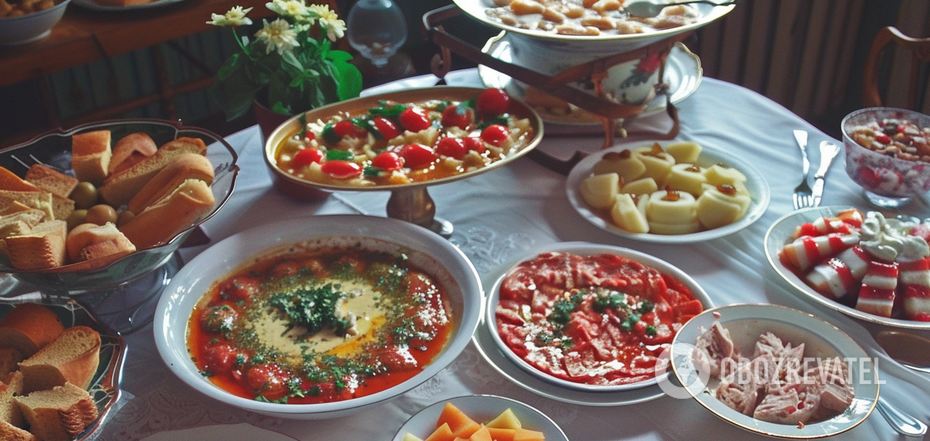Lifestyle
The Myth of Healthy Eating is Shattered: Why Food in the USSR Caused Early Wrinkles and Gray Hair
One of the key arguments of those who like to speculate about what a good country the USSR was is the allegedly high quality and naturalness of its food. These people claim that Soviet citizens ate only healthy food and that's why they were so strong and hardworking.
Maxym Myrovych, a Belarusian blogger and researcher of Soviet life, decided to debunk this myth. According to him, healthy eating existed in the USSR only in propaganda materials, and in reality, people ate poorly and poorly.
If we look at school textbooks from the 70s and 80s, we can see illustrations that demonstrate the preferred way of eating for a Soviet person. For breakfast, some kind of porridge (most likely semolina or oatmeal), a piece of cake, and tea. For lunch, a portion of fatty soup, a couple of heavily fried cutlets, and a slice of cucumber. For dinner, we have scrambled eggs with cheese and a butter sandwich. That is, even in idyllic images, we see a rather poor and far from nutritious diet.
But what dishes were popular and affordable in the USSR? The blogger provides a list by group. Each of them was shrouded in myths and stereotypes that do not stand up to criticism.
Soups. Soviet propaganda convinced that a hot and liquid dish for lunch saves from gastritis and other diseases of the gastrointestinal tract. However, in the canteens of the Land of the Soviets, soups were made from frozen bones, low-quality vegetables, stale cereals, and low-quality pasta. As a result, the dish had an unpleasant appearance and smell and contained almost no nutrients. Soups, however, were convenient to prepare for a large number of people or, in the case of home meals, for several days in advance. They were cooked in large pots and reheated as needed.
Porridges. In the quantities in which it was suggested that people in the USSR consume porridge, such dishes are not useful. After all, the main nutrient element of cereals is carbohydrates. For a good diet, you also need proteins and high-quality fats, as well as a sufficient amount of fiber from vegetables. But a plate of oatmeal with bread every day cannot be called a good diet. However, cereals gave workers energy for hard physical labor, so they were preferred. Due to their cheapness and "nourishing" properties, porridge was also popular in army and prison canteens.
Pasta. High-quality pasta is made from durum wheat. In the USSR, they used whatever they could grow. Often it was wheat with a high gluten content, so cooking pasta was more like cooking paste. In addition, the dish was another source of carbohydrates with a low content of other nutrients.
Potatoes. Potatoes were popular in the USSR because they could be cooked in a variety of ways: fried, boiled in their skins, baked, and mashed. The vegetable brought at least some variety to the poor menu of a Soviet person. If consumed in moderation, potatoes can be useful, as they contain a small amount of protein, some fiber, and certain vitamins and minerals. But mostly they are the same carbohydrates.
Sandwiches. In Soviet times, sandwiches could even be a festive dish. Just remember the version with sprats served at the New Year's table. But this was a way of saving food, because a small fish and a transparent slice of cucumber were placed on a rather thick slice of bread. On weekdays, the sandwich was filled with whatever was available – eggs, cheap sausage, low-quality cheese. All in order to enrich the carbohydrate diet with at least some other nutrients.
Candy and jam. Sweets in the USSR were made with a huge amount of sugar, and instead of natural cocoa, they used surrogates. These desserts were good for stimulating appetite, but they were not healthy. And, again, they were a source of huge amounts of carbohydrates.
Eggs. Chicken eggs are the cheapest type of animal protein. In a balanced diet, they take up a fairly small share. However Soviet citizens were forced to consume this product in large quantities to compensate for the lack of other proteins. In addition, they received a shock dose of not very healthy cholesterol.
Sausages, sausages, offal. The USSR tried to compensate for the shortage of whole meat with so-called meat products and offal. They were also popular because you could add a huge amount of extraneous ingredients to the minced meat, which would make the product nourishing, although it did not contain enough nutritional components. There was even a popular joke among citizens that doctor's sausage consisted mostly of toilet paper.
Bread. Even without analyzing the quality of the bread baked by Soviet bakeries, it is enough to recall the habit of Soviet citizens to eat absolutely everything with bread, even pasta, which is also a flour product. This was how people saved themselves from hunger because the available food not only did not cover the need for nutrients, but there was a significant shortage of them, and getting sausage, even bad sausage, was a quest.
If you look at photographs of Soviet people now, you can see the consequences of such a diet. Many people have bad skin with early wrinkles, prematurely graying hair, are overweight due to the consumption of large amounts of carbohydrates, and spoiled teeth.
Subscribe to the OBOZ.UA channels in Telegram and Viber to keep up with the latest events.



























